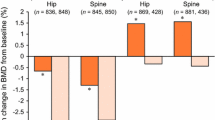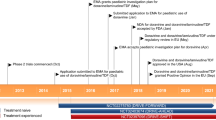Abstract
-
▴ Adefovir dipivoxil is an ester prodrug of the nucleoside reverse transcriptase inhibitor adefovir (PMEA), the prototype compound of the acyclic nucleoside phosphonates. It has better oral bioavailability than the parent compound.
-
▴ Adefovir dipivoxil 120mg once daily significantly reduced viral load compared with placebo when added to standard antiretroviral therapy in a 6-month, double-blind study in patients with HIV infection. Viral suppression was maintained during an additional 6-month nonblind extension phase.
-
▴ The drug was most effective in patients with baseline isolates containing the M184V lamivudine resistance mutation according to data from a virological substudy of a large placebo-controlled trial.
-
▴ Adefovir dipivoxil 60mg was as effective as 120mg (both once daily) after 20 weeks’ treatment in a randomised double-blind study in antiretroviral-experienced (protease inhibitor-naive) patients.
-
▴ Viral suppression was generally maintained in patients who developed new reverse transcriptase mutations during adefovir dipivoxil monotherapy or combination therapy for up to 12 months. No clear pattern of particular clinical resistance mutations has emerged.
-
▴ GI disturbances, hepatic effects and delayed renal abnormalities are the principal adverse events seen with adefovir dipivoxil. Reductions in serum free carnitine levels may occur and coadministration of L-carnitine is recommended.
Similar content being viewed by others
References
Naesens L, Snoeck R, Andrei G, et al. HPMPC (cidofovir), PMEA (adefovir) and related acyclic nucleoside phosphonate analogues: a review of their pharmacology and clinical potential in the treatment of viral infections. Antiviral Chem Chemother 1997 Jan; 8: 1–23
Naesens L, De Clercq E. Therapeutic potential of HPMPC (cidofovir), PMEA (adefovir) and related acyclic nucleoside phosphonate analogues as broad-spectrum antiviral agents. Nucleosides Nucleotides 1997; 16(7–9): 983–92
Balzarini J. Metabolism and mechanism of antiretroviral action of purine and pyrimidine derivatives. Pharm World Sci 1993; 16(2): 113–26
Holy A, Votruba I, Merta A, et al. Acyclic nucleotide analogues: synthesis, antiviral activity and inhibitory effects on some cellular and virus-encoded enzymes in vitro. Antiviral Res 1990; 13: 295–312
Balzarini J, Hao Z, Herdewijn P, et al. Intracellular metabolism and mechanism of anti-retrovirus action of 9-(2-phosphonylmethoxyethyl)adenine, a potent anti-human immunodeficiency virus compound. Proc Natl Acad Sci U S A 1991 Feb 15; 88: 1499–503
Srinivas RV, Connely M, Fridland A. (5)-1-(3-hydroxy-2-phosphonylmethoxypropyl)cytosine (HPMPC) inhibits HTV-1 replication in epithelial cells, but not T-lymphocytes. Antiviral Res 1997 Jun; 35: 23–7
Perno CF, Yarchoan R, Balzarini J, et al. Different pattern of activity of inhibitors of the human immunodeficiency virus in lymphocytes and monocyte/macrophages. Antiviral Res 1992 Apr; 17: 289–304
Perno C-F, Balestra E, Aquaro S, et al. Potent inhibition of human immunodeficiency virus and herpes simplex virus type 1 by 9-(2-phosphonylmethoxyethyl)adenine in primary macrophages is determined by drug metabolism, nucleotide pools, and cytokines. Mol Pharmacol 1996 Aug; 50: 359–66
Mulato AS, Cherrington JM. Anti-HIV activity of adefovir (PMEA) and PMPA in combination with antiretroviral compounds: in vitro analyses. Antiviral Res 1997 Nov; 36: 91–7
Balzarini J, Vahlenkamp T, Egberink H, et al. Antiretroviral activities of acyclic nucleoside phosphonates [9-(2-phosphonylmethoxyethyl)adenine, 9-(2-phosphonylmethoxyethyl)-guanine, (R)-9-(2-phosphonylmethoxypropyl)adenine, and MDL 74,968] in cell cultures and murine sarcoma virus-infected newborn NMRI mice. Antimicrob Agents Chemother 1997 Mar; 41: 611–6
Balzarini J, Naesens L, Slachmuylders J, et al. 9-(2-Phosphonylmethoxyethyl)adenine (PMEA) effectively inhibits retrovirus replication in vitro and simian immunodeficiency virus infection in rhesus monkeys. AIDS 1991 Jan; 5: 21–8
Balzarini J, Aquaro S, Perno CF, et al. Activity of the (R)-enantiomers of 9-(2-phosphonylmethoxypropyl)-adenine and 9-(2-phosphonylmethoxypropyl)-2,6-diaminopurine against human immunodeficiency virus in different human cell systems. Biochem Biophys Res Commun 1996 Feb 15; 219: 337–41
Srinivas RV, Robbins BL, Connelly MC, et al. Metabolism and in vitro antiretroviral activities of bis(pivaloyloxymethyl) prodrugs of acyclic nucleoside phosphonates. Antimicrob Agents Chemother 1993 Oct; 37: 2247–50
Shirasaka T, Chokekijchai S, Yamada A, et al. Comparative analysis of anti-human immunodeficiency virus type 1 activities of dideoxynucleoside analogs in resting and activated peripheral blood mononuclear cells. Antimicrob Agents Chemother 1995 Nov; 39: 2555–9
Starrett Jr JE, Tortolani DR, Hitchcock MJM, et al. Synthesis and in vitro evaluation of a phosphonate prodrug: bis(pivaloyloxymethyl) 9-(2-phosphonylmethoxyethyl)adenine. Antiviral Res 1992 Sep 1; 19: 267–73
Gu Z, Salomon H, Cherrington JM, et al. K65R mutation of human immunodeficiency virus type 1 reverse transcriptase encodes cross-resistance to 9-(2-phosphonylmethoxyethyl)-adenine. Antimicrob Agents Chemother 1995 Aug; 39: 1888–91
Foli A, Sogocio KM, Anderson B, et al. In vitro selection and molecular characterization of human immunodeficiency virus type 1 with reduced sensitivity to 9-[2-(phosphonomethoxy)ethyl]adenine (PMEA). Antiviral Res 1996 Oct; 32: 91–8
Cherrington JM, Mulato AS, Fuller MD, et al. Novel mutation (K70E) in human immunodeficiency virus type 1 reverse transcriptase confers decreased susceptibility to 9-[2-(phosphonomethoxy)ethyl]adenine in vitro. Antimicrob Agents Chemother 1996 Sep; 40: 2212–6
Gong Y-F, Marshall DR, Srinivas RV, et al. Susceptibilities of zidovudine-resistant variants of human immunodeficiency virus type 1 to inhibition by acyclic nucleoside phosphonates. Antimicrob Agents Chemother 1994 Jul; 38: 1683–7
Miller MD, Anton KE, Mulato AS, et al. Human immunodeficiency virus type 1 expressing the lamivudine-associated M184V mutation in reverse transcriptase shows increased susceptibility to adefovir and decreased replication capability in vitro. J Infect Dis 1999 Jan; 179: 92–100
Mulato AS, Lamy PD, Miller MD, et al. Genotypic and phenotypic characterization of human immunodeficiency virus type 1 variants isolated from AIDS patients after prolonged adefovir dipivoxil therapy. Antimicrob Agents Chemother 1998 Jul; 42(7): 1620–8
Cherrington JM, Mulato JS, Lamy PD, et al. Adefovir dipivoxil (bis-POM PMEA) therapy significntly decreases HIV RNA in patients with high-level AZT/3TC-resistant HIV [abstract no. I-84]. 38th Interscience Conference on Antimicrobial Agents and Chemotherapy; 1998 Sep 24–27; San Diego, 388
Caliò R, Villani N, Balestra E, et al. Enhancement of natural killer activity and interferon induction by different acyclic nucleoside phosphonates. Antiviral Res 1994 Jan; 23: 77–89
Del-Gobbo V, Foli A, Balzarini J, et al. Immunomodulatory activity of 9-(2-phosphonylmethoxyethyl)adenine (PMEA), a potent anti-HIV nucleotide analogue, on in vivo murine models. Antiviral Res 1991 Jul; 16: 65–75
Cundy KC. Clinical pharmacokinetics of the antiviral nucleotide analogues cidofovir and adefovir. Clin Pharmacokinet 1999 Feb; 36(2): 127–43
Cundy KC, Barditch-Crovo P, Walker RE, et al. Clinical pharmacokinetics of adefovir in human immunodeficiency virus type 1-infected patients. Antimicrob Agents Chemother 1995 Nov; 39: 2401–5
Cundy KC, Sue I-L, Visor GC, et al. Oral formulations of adefovir dipivoxil: in vitro dissolution and in vivo bioavailability in dogs. J Pharm Sci 1997 Dec; 86(12): 1334–8
Cundy KC, Shaw J-P, Lee WA. Oral, subcutaneous, and intramuscular bioavailabilities of the antiviral nucleotide analog 9-(2-phosphonylmethoxyethyl) adenine in cynomolgus monkeys. Antimicrob Agents Chemother 1994 Feb; 38: 365–8
Palu G, Stefanelli S, Rassu M, et al. Cellular uptake of phosphonylmethoxyalkylpurine derivatives. Antiviral Res 1991 Jul; 16: 115–9
Cihlár T, Rosenberg I, Votruba I, et al. Transport of 9-(2-phosphonomethoxyethyl)adenine across plasma membrane of HeLa S3 cells is protein mediated. Antimicrob Agents Chemother 1995 Jan; 39: 117–24
Shaw JP, Cundy KC. Biological screens of PMEA prodrugs. Poster presentation, 8th Annual Meeting of the American Association of Pharmaceutical Scientists; 1993 Nov 14–18; Lake Buena Vista (FL)
Annaert P, Kinget R, Naesens L, et al. Transport, uptake, and metabolism of the bis(pivaloyloxymethyl)-ester prodrug of 9-(2-phosphonylmethoxyethyl)adenine in an in vitro cell culture system of the intestinal mucosa (Caco-2). Pharm Res 1997 Apr; 14: 492–6
Naesens L, Balzarini J, Bischofberger N, et al. Antiretroviral activity and pharmacokinetics in mice of oral bis(pivaloyloxymethyl)-9-(2-phosphonylmethoxyethyl)adenine, the bis(pivaloyloxymethyl) ester prodrug of 9-(2-phosphonylmethoxyethyl)adenine. Antimicrob Agents Chemother 1996 Jan; 40: 22–8
Cundy KC, Fishback JA, Shaw J-P, et al. Oral bioavailability of the antiretroviral agent 9-(2-phosphonylmethoxyethyl) adenine (PMEA) from three formulations of the prodrug bis-(pivaloyloxymethyl)-PMEA in fasted male cynomolgus monkeys. Pharm Res 1994 Jun; 11: 839–43
Barditch-Crovo P, Toole J, Hendrix CW, et al. Anti-human immunodeficiency virus (HIV) activity, safety, and pharmacokinetics of adefovir dipivoxil (9-[2-(bis-pivaloyloxymethyl)-phosphonylmethoxyethyl]adenine) in HIV-infected patients. J Infect Dis 1997 Aug; 176: 406–13
Barditch-Crovo PA, Cundy KC, Wachsman M, et al. Pharmacokinetic profile of 9-[2-(bispivaloyloxy-methyl) phosphonylmethoxy]adenine (bis-POM PMEA), an orally bioavailable prodrug of the antiviral nucleotide, PMEA [abstract no. 488]. 2nd National Conference on Human Retroviruses and Related Infections; 1995 Jan 29–Feb 2; Washington DC, 145
Deeks SG, Collier A, Lalezari J, et al. The safety and efficacy of adefovir dipivoxil, a novel anti-human immunodeficiency virus (HIV) therapy, in HIV-infected adults: a randomized, double-blind, placebo-controlled trial. J Infect Dis 1997 Dec; 176: 1517–23
Hardy WD. Adefovir dipivoxil study 408: a multicenter, randomized, double-blind placebo-controlled study of the efficacy and safety of adefovir dipivoxil (ADV) when added to standard antiretroviral therapy for the treatment of HIV-infected patients. Oral presentation, 4th International Congress on Drug Therapy in HIV Infection; 1998 Nov 8–12; Glasgow
Kahn J, Lagakos S, Weng D, et al. A multicenter, randomized, double-blind placebo controlled study of the efficacy and safety of adefovir dipivoxil (Adv) when added to standard antiretroviral therapy (Art) [abstract no. I-108]. 38th Interscience Conference on Antimicrobial Agents and Chemotherapy; 1998 Sep 24–27; San Diego, 396
Brosgart C. GS-417: a randomized, double-blind study of adefovir dipivoxil (ADV) at two dose levels (120 mg 60 mg) as part of combination therapy in NRTI-experienced patients with no prior PI therapy. Oral presentation, 12th International Conference on Antiviral Research; 1999 Mar 21–26; Jerusalem
Gallant J. Study GS-96-411: arandomized, open-label study of adefovir dipivoxil (ADV) and indinavir (IDV) in combination with AZT, 3TC or d4T for the treatment of therapy-naive HIV-infected patients. Oral presentation, 38th Interscience Conference on Antimicrobial Agents and Chemotherapy; 1998 Sep 24–27; San Diego
Wiznia A, Nelson R, Van Dyke R, et al. Phase I/II study of combination adefovir dipivoxil (ADV) and nelfinavir (NLF) in children with HIV infection and previous antiretroviral experience [abstract no. I-9]. 38th Interscience Conference on Antimicrobial Agents and Chemotherapy; 1998 Sep 24–27; San Diego, 365
Barriere S, Winslow D, Coakley D, et al. Safety of adefovir dipivoxil in the treatment of HIV infection [abstract no. 12386]. 12th World AIDS Conference; 1998 Jun 28–Jul 3; Geneva: 90–1
Gilead Sciences. Preveon (adefovir dipivoxil): information for caregivers [online]. Available from: http://www.gilead.com [Accessed 1998 Nov 2]
Nuessle SJ, Barriere SL, Rooney JF, et al. The Preveon® Expanded Access Program: safety of adefovir dipivoxil (ADV) in antiretroviral treatment experienced patients with advanced HIV disease (poster no. 379). Poster presentation, 6th Conference on Retroviruses and Opportunistic Infections; 1999 Jan 31–Feb 4; Chicago
Author information
Authors and Affiliations
Corresponding author
Rights and permissions
About this article
Cite this article
Noble, S., Goa, K.L. Adefovir Dipivoxil. Drugs 58, 479–487 (1999). https://doi.org/10.2165/00003495-199958030-00010
Published:
Issue Date:
DOI: https://doi.org/10.2165/00003495-199958030-00010




